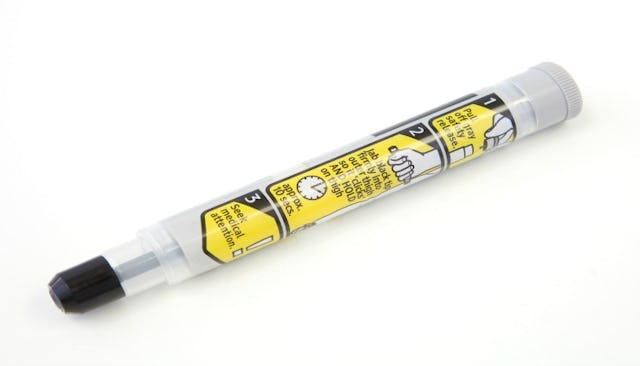The EpiPen Is A Luxury Only Some Can Afford

This week, drug company Mylan raised the cost of an EpiPen more than 400%. Friends of mine on Facebook say they’re now forced into a copay of $250 for one, while NBC News says it costs upwards of $500 without insurance. Many are unable to afford the cost and are now at risk for life-threatening anaphylaxis. This is terrifying.
Only a mother of a severely allergic child knows how terrifying this can be. When my son was 2, he was stung at a playdate by something, a wasp or bee. The area began to itch. Then he started to break out in spots. By the time I got home, five minutes later, his entire body had swollen so much he could barely open his eyes.
My son went into shock on the way to the hospital and was nearly intubated. He had to do a weeklong course of steroids — and a 2-year-old on steroids is exactly what you’d imagine — along with the Benadryl they’d given him at the hospital, which had arrested the reaction. He stayed covered in spots for a day and a half afterwards. And he came away with a prescription for an EpiPen.
An EpiPen works like this: While my son knows to stay away from bees and wasps, imagine he slips up and gets stung. I whip out the EpiPen we carry everywhere in a special pouch. I take it out and uncap it. Then I sit on my son, who’s afraid of shots, and plunge the needle into his thigh through his clothes. I hold it there for the count of 10.
According to Mylan, the epinephrine “constricts blood vessels to increase blood pressure, relaxes smooth muscles in the lungs to reduce wheezing and improve breathing, stimulates the heart (increases heart rate) and works to reduce hives and swelling that may occur around the face and lips.” But that’s not the end of it; my son still has to go to the hospital to make sure we’ve arrested the anaphylactic shock, which can in extreme cases kill.
We have two EpiPens, one to use and one in case the other doesn’t work. My son carries them everywhere, or rather, I do. An EpiPen arrests, or at least delays, an anaphylactic shock, which causes hives; breathing abnormalities; and a swelling of the lips and tongue, which further complicates breathing. It can also cause heart problems, including a drop in blood pressure, increased heart rate, and chest pain. The danger of anaphylaxis is that the airway will close, preventing breathing and killing the sufferer. Anaphylaxis is no mild health problem, and its only solution in the short term — without a hospital — is an EpiPen.
NBC News also reported that Mylan said in a statement that prices for the product have “changed over time to better reflect important product features and the value the product provides” and that they have “made a significant investment to support the device over the past years.”
However, many would argue the low production cost for epinephrine in no way justifies a 400% or 500% price hike. The Huffington Post reports that the price has risen from $100 for a pack of two pens in 1999 to over $600 today. Meanwhile, Mylan’s main competitor, Auvi-Q, issued a full recall last year, giving Mylan an overwhelming advantage in the portable epinephrine market, according to the New York Daily News.
Many people — many parents — can no longer afford EpiPens, which must be replaced once a year. Parents may consequently keep EpiPens past their expiration date, leading to inaccurate dosing or lowered efficacy. Considering that approximately 1 in 50 Americans suffer from anaphylactic allergies — the most common being insect stings and peanut allergies — this poses a major health threat.
Here’s hoping that the other company brings their drug back on the market or other companies emerge with additional solutions to epinephrine delivery. Until then, anaphylactic protection is a luxury only some can afford. And without a safety net, some parents will tremble at the thought of their children being stung or accidentally ingesting their allergen. That is terrifying.
This article was originally published on